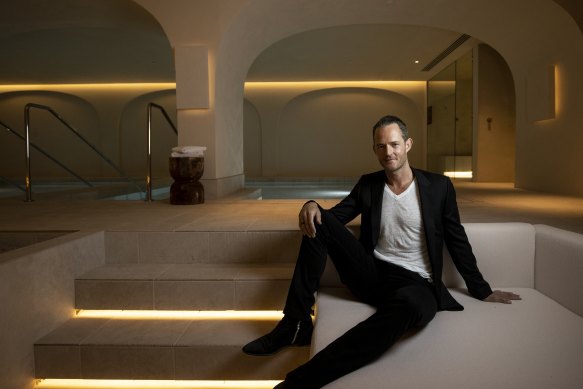Would Tim Gurner’s economic plan heal Australia’s woes? It’s complicated

Save articles for later
Add articles to your saved list and come back to them any time.
Either billionaire property developer Tim Gurner is speaking the unvarnished truth about Australia’s economic ills – or he’s an out-of-touch billionaire property developer who has no idea how the economy works.
Gurner has attracted widespread attention, and some creative memes, since telling The Australian Financial Review’s property summit this week that people have lost their work ethic, productivity is going down the gurgler and the economy needs a good dose of salts.
Property developer Tim Gurner.Credit: Arsineh Houspian
“In my view, we need to see pain in the economy,” he said.
What sort of pain?
“We need to see unemployment rise. Unemployment has to jump 40 to 50 per cent,” said the guy who kick-started his working career with a $34,000 loan from his grandfather.
Gurner has garnered plenty of attention for his insight. US Democrat congresswoman Alexandria Ocasio-Cortez shared to her 13.2 million followers on X a video of his comments followed by this observation: “Reminder that major CEOs have skyrocketed their own pay so much that the ratio of CEO-to-worker pay is now at some of the highest levels ever recorded.”
New York Democrat Alexandria Ocasio-Cortez.Credit: AP
The attention was partly due to his proposed increase translating into 270,000 Australians losing their jobs.
Such a rise would take the number of people without a job back to the level seen in early 2021. That’s around the 800,000 mark. Outside the COVID recession, you have to go back to the mid-1990s for so many Australians to be out of work.
In Gurner’s take, the pain suffered by these 270,000 extra people out of work would benefit the broader economy. It’s a view not dissimilar to Shrek’s Lord Farquaad who told his soldiers who were to save Princess Fiona from a dragon, “some of you may die, but it’s a sacrifice I am willing to make”.
There would also be macroeconomic ramifications.
The unemployment rate (currently 3.7 per cent) would lift to about 5.5 per cent. Pre-COVID, that was a level the Reserve Bank found too high and which forced it into halving the official cash rate through 2019.
Unemployment at that level would undoubtedly reduce inflation but almost certainly drive the economy into a recession. The Reserve Bank would have to step in, cutting interest rates in a bid to get people back into work and stop the misery that comes with mass job losses.
And the first part of the economy to benefit? The housing sector, as people could afford to buy new properties.
The Reserve Bank has admitted its interest rate increases over the past year will inevitably lead to a lift in the jobless rate. But not to the level advocated by Gurner.
Gurner went further, arguing the COVID period had led to a “systemic change where employees feel the employer is extremely lucky to have (them) as opposed to the other way around”.
“We’ve got to kill that attitude and that has to come through hurting the economy, which is what the whole world is trying to do, the governments around the world are trying to increase unemployment, to give that some sort of normality.”
Gurner got wrong who is trying to lift unemployment – it is central banks, not elected governments. And his views around workers and their fealty to employers sounds like something out of a Charles Dickens novel.
But his broader point – that the world economy has to get back to some sort of normality – was not incorrect.
A decade of ultra-low interest rates, due to the fallout from the global financial crisis that then ran into the deepest economic downturn since the 1930s, has left the world’s economy in a very strange place.
Central banks, including the RBA, created trillions of dollars out of thin air and took interest rates below zero to bolster the economy. There’s nothing normal about any of this.
According to Gurner, COVID has also made workers lazy. The idea from business leaders that there are a bunch of lazy workers out there dragging down the country is not new.
Canadian academic Paul Fairie has collected excerpts from American newspapers of business leaders saying “nobody wants to work anymore”. It’s a refrain has found uttered almost every year since the 1890s.
Gurner’s broader complaint, linking productivity to the amount of time a worker is on the job, is an all too common misconception.
Australian working hours are actually increasing at the moment. The problem is that the amount being produced is actually going backwards.
Some of that is due to businesses, stung by staff shortages during COVID, hoarding workers so that they aren’t again left short-changed. Part of it is the “make-busy” work that so many Australians now spend their time on.
More broadly, productivity in this country is affected by the choices we make.
Rather than pour money into start-up businesses in cutting-edge technologies or innovative solutions to some of the country’s most pressing problems, Australians invest in bricks and mortar.
Property development delivers beautiful homes. But unless its dragging people out of hovels into affordable and healthy accommodation, it does little to boost productivity.
The Morning Edition newsletter is our guide to the day’s most important and interesting stories, analysis and insights. Sign up here.
Most Viewed in Politics
From our partners
Source: Read Full Article

